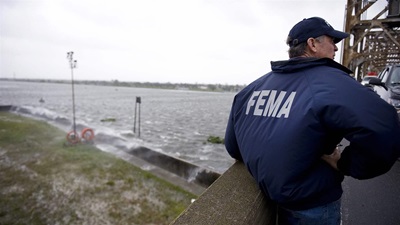Transformed by Tragedy: How Alabama Is Becoming a Model in Disaster Resilience
14 years after devastating tornadoes, state forges a practical approach to safer, stronger communities

Lasting progress takes time and is often sparked by significant—if tragic—events. Such is the case in Alabama where, 14 years after catastrophic tornadoes swept across the state and killed 240 people, the state is emerging as a leader in disaster resilience.
In the years since the tornado outbreak of April 27, 2011, even as Alabama faced hurricanes, floods, and other extreme weather, state leaders have built a coordinated, forward-looking approach to disasters—one grounded in data, community needs, and experience.
Alabama’s fortified foundation
Years before “resilience” became a bipartisan policy goal in Congress and statehouses throughout the country, Alabama began investing in it.
In 2011, the state passed the Strengthen Alabama Homes Act, laying groundwork for a first-in-the-nation grant program to help homeowners retrofit their properties against wind-related disasters in exchange for insurance premium discounts. Since then, the Strengthen Alabama Homes (SAH) program has become a national model, replicated in Arkansas, Florida, Georgia, Kentucky, Louisiana, Minnesota, Mississippi, New Mexico, Oklahoma, and South Carolina. Further, Alabama experts are routinely called upon to share their insights into best practices at both the state and federal levels.
Using dedicated state funds, SAH offers homeowners grants of up to $10,000 for roof upgrades that meet national insurance industry standards. To date, the program has awarded more than $86 million in grants, retrofitted over 8,700 homes, and brought the number of homes in Alabama that meet the industry standards to more than 53,000—the most in the country. A 2025 study following Hurricane Sally found that such homes had up to 74% fewer insurance claims and significantly lower loss costs than those that didn’t meet those standards.
From local success to statewide resilience
By 2022, despite the success of SAH, Alabama had not yet developed a unified strategy across agencies, sectors, and regions.
But that began to change. Over the course of that year, Pew worked closely with Governor Kay Ivey’s administration to explore how Alabama could build on existing strengths—like SAH—and begin planning more holistically for long-term risk.
That work reached a milestone in Executive Order 736, which Governor Ivey issued in May 2023, establishing the Alabama Resilience Council (ARC) to coordinate resilience-related activities across state government and facilitate collaboration with the private sector. The order positioned resilience not just as a policy ambition, but as a practical and operational priority.
“Protecting the well-being of our people, both physically and financially, should be a top priority shared by leaders at all levels of government,” Governor Ivey said when signing E.O. 736. “By proactively reimagining our approach to events with harmful effects on Alabamians before they occur, we can save lives, protect jobs, and ensure our state’s future remains bright.”
Pew experts were asked to join the ARC’s first meeting in August 2023 as well as subsequent meetings that brought together government officials, private sector partners, and subject-matter experts. Over the following year, the council formed working groups focused on preparedness, public awareness, and water infrastructure, and, in October 2024, it delivered to Governor Ivey its first report outlining a path forward. The report recommended that the state develop a comprehensive plan, conduct a full inventory of assets, enhance cross-agency coordination, and put in place a chief resilience officer (CRO) to lead implementation.
Pew has contributed research, policy guidance, and support across the working groups and helped the council shape actionable recommendations grounded in national best practices.
As Alabama Insurance Commissioner Mark Fowler, one of the ARC’s two agency co-chairs, said, “We know we have the tools to blunt Mother Nature’s impact, and our job on the ARC is to find the best ways to put them to work for the people of Alabama. That’s where Pew’s expertise has been so instrumental, helping our state coordinate across agencies and stakeholders to create a unified resilience plan and giving us ideas and ways to scale mitigation and resilience.”
A statewide commitment
Building on the ARC’s work, in 2025, Alabama lawmakers introduced two companion bills—House Bill 603, sponsored by Representative Chip Brown (R-Mobile), and Senate Bill 346, sponsored by Senator Steve Livingston (R-Scottsboro)—to form the next layer of the state’s resilience infrastructure.
Informed by evidence-based research and best practices, the legislation—the Alabama Resilience Council Act—sought to codify resilience practices and procedures in state law, make the ARC permanent, establish a CRO position, and require a statewide resilience plan that would include a comprehensive risk and vulnerability assessment and implementation strategy, mirroring the ARC’s recommendations.
The Alabama Resilience Council Act would also require the state to prioritize actions with multiple benefits, such as those that reduce disaster risk while promoting environmental stewardship, economic stability, and public health. The measure shows a serious commitment to resilience as a set of responsibilities embedded in government.
While neither version of the bill received floor votes prior to the end of the 2025 legislative session, H.B. 603 advanced out of the committee of jurisdiction with unanimous support and is expected to be reintroduced in 2026.
Marking the 10th anniversary of the 2011 tornado disaster, Governor Ivey said, “Over the last 10 years in the aftermath of this horrific tragedy, Alabamians have proven their strength and resiliency in rebuilding their broken communities.”
Now Alabama can take the next step. By passing comprehensive disaster resilience legislation when the Legislature reconvenes next year, state leaders can reduce disaster risks, strengthen communities, and advance environmental stewardship and conservation.
With a foundation for statewide resilience rooted in evidence, collaboration, and lived experience, Alabama is poised to continue showing other states how to prepare for and learn from disasters, and evolve in their wake.










